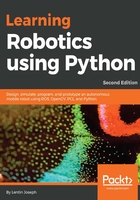
The ROS Computation Graph
The ROS Computation Graph is the peer-to-peer network of ROS systems that processes data. The basic features of ROS Computation Graph are nodes, ROS Master, the parameter server, messages, and services:
- Nodes: The ROS node is a process that uses ROS functionalities to process the data. A node basically computes. For example, a node can process the laser scanner data to check whether there is any collision. A ROS node is written with the help of an ROS client library (such as roscpp and rospy), which will be discussed in the upcoming section.
- ROS Master: The ROS nodes can connect to each other using a program called ROS Master. This provides the name, registration, and lookup to the rest of the computation graph. Without starting the master, the nodes will not find each other and send messages.
- Parameter server: The ROS parameters are static values that are stored in a global location called the parameter server. From the parameter server, all the nodes can access these values. We can even set the scope of the parameter server as private or public so that it can access one node or access all nodes.
- ROS topics: The ROS nodes communicate with each other using a named bus called ROS topic. The data flows through the topic in the form of messages. The sending of messages over a topic is called publishing, and receiving the data through a topic is called subscribing.
- Messages: A ROS message is a data type that can consist of primitive data types, such as integers, floating points, and Booleans. The ROS messages flow through the ROS topic. A topic can only send/receive one type of message at a time. We can create our own message definition and send it through the topics.
- Services: We have seen that the publish/subscribe model using ROS topics is a very easy way of communicating. This communication method is a one-to-many mode of communication, meaning that a topic can be subscribed to by any number of nodes. In some cases, we may also require a request/reply kind of interaction, which is usually used in distributed systems. This kind of interaction can be done using ROS services. The ROS services work in a similar way to ROS topics in that they have a message type definition. Using that message definition, we can send the service request to another node that provides the service. The result of the service will be sent as a reply. The node has to wait until the result is received from the other node.
- Bags: These are formats in which to save and play back the ROS topics. ROS bags are an important tool to log the sensor data and the processed data. These bags can be used later for testing our algorithm offline.
The following diagram shows how topics and services work between the nodes and the Master:

Communication between the ROS nodes and the ROS Master
In the preceding diagram, you can see two ROS nodes with the ROS Master in between them. One thing we have to remember is, before starting any nodes in ROS, you should start the ROS Master. The ROS Master acts like a mediator between nodes for exchanging information about other ROS nodes in order to establish communication. Say that Node 1 wants to publish a topic called /xyz with message type abc. It will first approach the ROS Master, and says I am going to publish a topic called /xyz with message type abc and share its details. When another node, say Node 2, wants to subscribe to the same topic of /xyz with the message type of abc, the Master will share the information about Node 1 and allocate a port to start communication between these two nodes directly without communicating with the ROS Master.
The ROS services works in the same way. The ROS Master is a kind of DNS server, which can share the node details when the second node requests a topic or service from the first node. The communication protocol ROS uses is TCPROS (http://wiki.ros.org/ROS/TCPROS), which basically uses TCP/IP sockets for the communication.